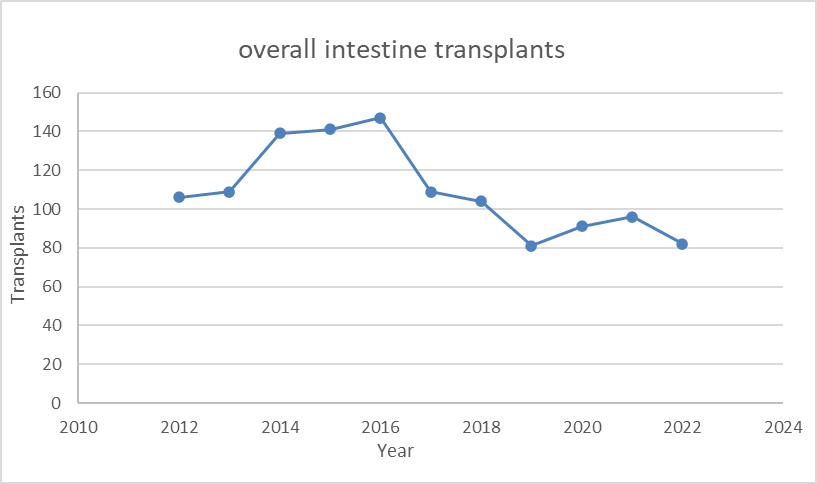Monday Poster Session
Category: Small Intestine
P4047 - Trends and Indications for Intestinal (Small Bowel) Transplantation in the United States: A 12-Year Analysis (2012–2023) Using UNOS Data
Monday, October 27, 2025
10:30 AM - 4:00 PM PDT
Location: Exhibit Hall
- MD
Mati Ullah Dad Ullah, MBBS
University of Oklahoma Health Sciences Center
Oklahoma City, OK
Presenting Author(s)
Mati Ullah Dad Ullah, MBBS1, Syed Bilal Shah, MD2, Rohullah Rasikh, MBBS3, Ashraf Ullah, MD4, Fnu Khalil ur rehman, MBBS5, Ijlal Akbar Ali, MD6
1University of Oklahoma Health Sciences Center, Oklahoma City, OK; 2Beth Israel Deaconess Medical Center, Harvard Medical School, Boston, MA, Boston, MA; 3Landmark Medical Center, Woonsocket, RI; 4Beth Israel Deaconess Medical Center, Harvard Medical School, Boston, MA; 5Carle Foundation hospital, Urbana, IL; 6Oklahoma University Health Sciences Center, Oklahoma City, OK
Introduction: Intestinal (Small Bowel) transplantation remains a rare but life-saving intervention for patients with
irreversible intestinal failure, often accompanied by liver dysfunction. Understanding
evolving indications and procedural trends is essential for improving outcomes and
guiding healthcare policy.
Methods: We conducted a retrospective analysis of intestinal transplant data from the United
Network for Organ Sharing (UNOS) database between 2012 and 2023. Transplant
volumes were stratified by indication, type (intestine-only vs. combined liver-intestine),
and year. Primary etiologies included congenital short gut syndrome (SGS),
enteropathies, necrotizing enterocolitis (NEC), non-congenital SGS, pseudo-obstruction,
and other/unknown causes.
Results: There was a marked decline in total intestinal transplant volume over the 12-year
period, decreasing from a peak of 147 transplants in 2016 to 95 in 2023, representing a
35% overall reduction [Figure 1]. Non-congenital short gut syndrome (SGS) was the most
common indication throughout all years. In contrast, congenital SGS showed a steep
decline, falling from 28 cases in 2014 to just 7 in 2023. Other etiologies, such as
necrotizing enterocolitis (NEC), pseudo-obstruction, and enteropathies remained
relatively stable, contributing a smaller portion of cases. The “Other/unknown” category
showed notable variability, with a peak of 39 cases observed in 2015. Intestine-only
transplants consistently outnumbered combined liver-intestine procedures. While
intestine-liver transplants peaked in 2014 and 2016 with 35 and 32 cases respectively,
the number declined to 16 by 2023.
Discussion: UNOS data from 2012–2023 reveal a steady decline in intestinal transplant volume,
despite stable indications. The reduction may reflect advances in intestinal failure
management, including parenteral nutrition and surgical approaches. Continued
surveillance of transplant trends and outcomes is warranted to inform clinical and policy
decisions.

Figure: Figure 1: Showing Trend of Intestinal Transplantation over time
Disclosures:
Mati Ullah Dad Ullah indicated no relevant financial relationships.
Syed Bilal Shah indicated no relevant financial relationships.
Rohullah Rasikh indicated no relevant financial relationships.
Ashraf Ullah indicated no relevant financial relationships.
Fnu Khalil ur rehman indicated no relevant financial relationships.
Ijlal Akbar Ali indicated no relevant financial relationships.
Mati Ullah Dad Ullah, MBBS1, Syed Bilal Shah, MD2, Rohullah Rasikh, MBBS3, Ashraf Ullah, MD4, Fnu Khalil ur rehman, MBBS5, Ijlal Akbar Ali, MD6. P4047 - Trends and Indications for Intestinal (Small Bowel) Transplantation in the United States: A 12-Year Analysis (2012–2023) Using UNOS Data, ACG 2025 Annual Scientific Meeting Abstracts. Phoenix, AZ: American College of Gastroenterology.
1University of Oklahoma Health Sciences Center, Oklahoma City, OK; 2Beth Israel Deaconess Medical Center, Harvard Medical School, Boston, MA, Boston, MA; 3Landmark Medical Center, Woonsocket, RI; 4Beth Israel Deaconess Medical Center, Harvard Medical School, Boston, MA; 5Carle Foundation hospital, Urbana, IL; 6Oklahoma University Health Sciences Center, Oklahoma City, OK
Introduction: Intestinal (Small Bowel) transplantation remains a rare but life-saving intervention for patients with
irreversible intestinal failure, often accompanied by liver dysfunction. Understanding
evolving indications and procedural trends is essential for improving outcomes and
guiding healthcare policy.
Methods: We conducted a retrospective analysis of intestinal transplant data from the United
Network for Organ Sharing (UNOS) database between 2012 and 2023. Transplant
volumes were stratified by indication, type (intestine-only vs. combined liver-intestine),
and year. Primary etiologies included congenital short gut syndrome (SGS),
enteropathies, necrotizing enterocolitis (NEC), non-congenital SGS, pseudo-obstruction,
and other/unknown causes.
Results: There was a marked decline in total intestinal transplant volume over the 12-year
period, decreasing from a peak of 147 transplants in 2016 to 95 in 2023, representing a
35% overall reduction [Figure 1]. Non-congenital short gut syndrome (SGS) was the most
common indication throughout all years. In contrast, congenital SGS showed a steep
decline, falling from 28 cases in 2014 to just 7 in 2023. Other etiologies, such as
necrotizing enterocolitis (NEC), pseudo-obstruction, and enteropathies remained
relatively stable, contributing a smaller portion of cases. The “Other/unknown” category
showed notable variability, with a peak of 39 cases observed in 2015. Intestine-only
transplants consistently outnumbered combined liver-intestine procedures. While
intestine-liver transplants peaked in 2014 and 2016 with 35 and 32 cases respectively,
the number declined to 16 by 2023.
Discussion: UNOS data from 2012–2023 reveal a steady decline in intestinal transplant volume,
despite stable indications. The reduction may reflect advances in intestinal failure
management, including parenteral nutrition and surgical approaches. Continued
surveillance of transplant trends and outcomes is warranted to inform clinical and policy
decisions.

Figure: Figure 1: Showing Trend of Intestinal Transplantation over time
Disclosures:
Mati Ullah Dad Ullah indicated no relevant financial relationships.
Syed Bilal Shah indicated no relevant financial relationships.
Rohullah Rasikh indicated no relevant financial relationships.
Ashraf Ullah indicated no relevant financial relationships.
Fnu Khalil ur rehman indicated no relevant financial relationships.
Ijlal Akbar Ali indicated no relevant financial relationships.
Mati Ullah Dad Ullah, MBBS1, Syed Bilal Shah, MD2, Rohullah Rasikh, MBBS3, Ashraf Ullah, MD4, Fnu Khalil ur rehman, MBBS5, Ijlal Akbar Ali, MD6. P4047 - Trends and Indications for Intestinal (Small Bowel) Transplantation in the United States: A 12-Year Analysis (2012–2023) Using UNOS Data, ACG 2025 Annual Scientific Meeting Abstracts. Phoenix, AZ: American College of Gastroenterology.
